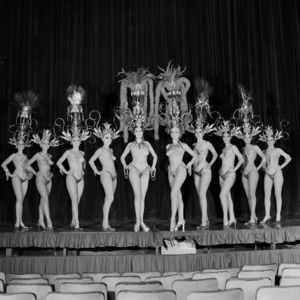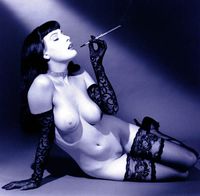Vedette (Cabaret)

A vedette is the main female artist of a show derived from cabaret and its subcategories of revue, vaudeville, music hall or burlesque. The purpose of the vedette is to entertain and captivate the public. The vedette has to know how to sing, dance, and act on stage. Particularly accomplished artistes are considered super vedettes or first vedettes. Vedettes often appear alongside groups of dancers, flashy and revealing costumes, magicians, comedians, jugglers, or even performing animals. Vedettes specializing in burlesque generally do a striptease. They may also perform nude on stage.
In the 20th century, vedette shows were successful in the cabarets, theaters, and nightclubs of countries such as Spain, France, Argentina, and Mexico. Paris and Las Vegas were considered the main cradle of the vedettes.
Etymology
Vedette is a French word originally used to designate an artist of great fame and notoriety. The term underwent changes over the years. From the early twentieth century, it began to be used to designate the main female artists of the shows of a cabaret such as burlesque, vaudeville, music hall or revue. The zenith of fame and popularity of these women coincided with various historical moments of 20th century sexual liberation: the 1920s, 1940s and 1970s.
The vedettes began their rise in popularity in France at the beginning of the 20th century. After France, they have gained greater popularity in Latin countries, both in Europe (Spain) and North and South America (Argentina and Mexico), where they caused a furor in the nightlife at different times. The term is little used in English-speaking countries, although in the United States there are very popular shows of cabaret and burlesque in Las Vegas, where it is often confused with showgirls. Venues such as Le Lido, the Moulin Rouge, and the Crazy Horse in France, the Teatro Maipo and the Teatro El Nacional in Argentina, and the Teatro de la Ciudad "Esperanza Iris" in Mexico are or were famous for their vedette shows.
United States
The term "vedette" is not commonly used in the United States or other Anglo-Saxon countries (here called "showgirls"). Las Vegas is considered, after Paris, as the main venue for revue shows and musicals worldwide.
The British Lydia Thompson became a leading dancer and actress in burlesques on the London stage. She introduced Victorian burlesque to America with her troupe the "British Blondes", in 1868, to great acclaim and notoriety.
Of the most famous American vedettes, stand out May Yohé, one of the most valued figures of the vaudeville at the beginning of the century; The aforementioned Josephine Baker, who ended up consecrating herself in France, where she was more popular than in her own country; Fanny Brice, star of the famous Ziegfeld Follies, queen of the theater, revues and later also star of cinema and the radio; Sally Rand, actress and dancer, specializing in fan dancing, which she popularized at the Paramount Club, and who because of the postures considered indecent she adopted with the dance was sometimes arrested. Also conceived the famous dance of the bubble; Zorita, famous for her shows where she played double roles and for her dances where she used boas and other exotic animals; Evelyn West, also known as "The Hubba Hubba Girl," a burlesque legend of the forties, fifties and sixties; Ann Corio, who also works in several Hollywood films; Mae West, who achieved tremendous fame, first in theater and then in Hollywood, where she scandalized censorship for her provocative behavior and spicy phrases. In the 1950s and 1960s, she achieved fame in her shows, which included groups of dancers and bodybuilders; Gypsy Rose Lee, immortalized in the famous autobiographical musical Gypsy. Her innovations consisted of a casual style against the spasmodic movements of other strippers (she emphasized the joke during the striptease) and brought a keen sense of humor to her performances. She was one of the main stars of Minsky's Burlesque, with whom she worked four years. Working with the Minsky brothers was arrested several times. Another important figure of this time was Novita "The Pixie of Burlesque", one of the founders of the Exotic Dancers League (EDL). In the 1940s and 1950s, the exotic dancer Lottie 'The Body' Graves also shone in the burlesque. She was known as "The Black Gypsy Rose Lee". In the 1950s and 1960s Jennie Lee[1] was considered one of the queens of burlesque.
In the 1960s and 1970s some burlesque figures peaked in the United States, particularly at the shows offered in Las Vegas. Of these are highlighted Tempest Storm, Lili St. Cyr, Blaze Starr, Kitten Natividad, Tura Satana, Bambi Jones Princess Cheyenne, Satan's Angel.
The most important in recent years has been Liza Minnelli.
Today, among the most famous vedettes in the United States are Dita Von Teese, who was the star of Crazy Horse, Julie Atlas Muz, Michelle L'amour, Amanda Lepore, Catherine D'lish, Miss Dirty Martini, the British Immodesty Blaze, Angie Pontani, Jo Weldon and the Singaporean Sukki Singapora, the first international burlesque artist in Singapore. Singapora became the first burlesque artist in the world to be invited to tea at Buckingham Palace as a recognition of her contribution to the arts as an Asian model.
Sources
Chat rooms • What links here • Copyright info • Contact information • Category:Root

